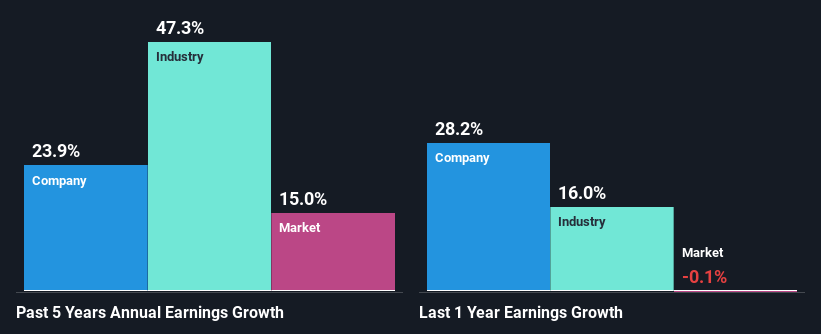Most readers would already be aware that Vita Life Sciences’ (ASX:VLS) stock increased significantly by 36% over the past three months. Given the company’s impressive performance, we decided to study its financial indicators more closely as a company’s financial health over the long-term usually dictates market outcomes. Particularly, we will be paying attention to Vita Life Sciences’ ROE today.
Return on Equity or ROE is a test of how effectively a company is growing its value and managing investors’ money. Put another way, it reveals the company’s success at turning shareholder investments into profits.
Check out our latest analysis for Vita Life Sciences
How Do You Calculate Return On Equity?
Return on equity can be calculated by using the formula:
Return on Equity = Net Profit (from continuing operations) ÷ Shareholders’ Equity
So, based on the above formula, the ROE for Vita Life Sciences is:
21% = AU$9.1m ÷ AU$43m (Based on the trailing twelve months to December 2023).
The ‘return’ is the income the business earned over the last year. Another way to think of that is that for every A$1 worth of equity, the company was able to earn A$0.21 in profit.
What Has ROE Got To Do With Earnings Growth?
So far, we’ve learned that ROE is a measure of a company’s profitability. We now need to evaluate how much profit the company reinvests or “retains” for future growth which then gives us an idea about the growth potential of the company. Generally speaking, other things being equal, firms with a high return on equity and profit retention, have a higher growth rate than firms that don’t share these attributes.
A Side By Side comparison of Vita Life Sciences’ Earnings Growth And 21% ROE
To begin with, Vita Life Sciences seems to have a respectable ROE. And on comparing with the industry, we found that the the average industry ROE is similar at 21%. Consequently, this likely laid the ground for the impressive net income growth of 24% seen over the past five years by Vita Life Sciences. However, there could also be other drivers behind this growth. For example, it is possible that the company’s management has made some good strategic decisions, or that the company has a low payout ratio.
Next, on comparing with the industry net income growth, we found that Vita Life Sciences’ reported growth was lower than the industry growth of 47% over the last few years, which is not something we like to see.
The basis for attaching value to a company is, to a great extent, tied to its earnings growth. It’s important for an investor to know whether the market has priced in the company’s expected earnings growth (or decline). This then helps them determine if the stock is placed for a bright or bleak future. What is VLS worth today? The intrinsic value infographic in our free research report helps visualize whether VLS is currently mispriced by the market.
Is Vita Life Sciences Efficiently Re-investing Its Profits?
The three-year median payout ratio for Vita Life Sciences is 41%, which is moderately low. The company is retaining the remaining 59%. This suggests that its dividend is well covered, and given the high growth we discussed above, it looks like Vita Life Sciences is reinvesting its earnings efficiently.
Moreover, Vita Life Sciences is determined to keep sharing its profits with shareholders which we infer from its long history of paying a dividend for at least ten years.
Conclusion
On the whole, we feel that Vita Life Sciences’ performance has been quite good. Particularly, we like that the company is reinvesting heavily into its business, and at a high rate of return. As a result, the decent growth in its earnings is not surprising. If the company continues to grow its earnings the way it has, that could have a positive impact on its share price given how earnings per share influence long-term share prices. Let’s not forget, business risk is also one of the factors that affects the price of the stock. So this is also an important area that investors need to pay attention to before making a decision on any business. Our risks dashboard would have the 2 risks we have identified for Vita Life Sciences.
Have feedback on this article? Concerned about the content? Get in touch with us directly. Alternatively, email editorial-team (at) simplywallst.com.
This article by Simply Wall St is general in nature. We provide commentary based on historical data and analyst forecasts only using an unbiased methodology and our articles are not intended to be financial advice. It does not constitute a recommendation to buy or sell any stock, and does not take account of your objectives, or your financial situation. We aim to bring you long-term focused analysis driven by fundamental data. Note that our analysis may not factor in the latest price-sensitive company announcements or qualitative material. Simply Wall St has no position in any stocks mentioned.


